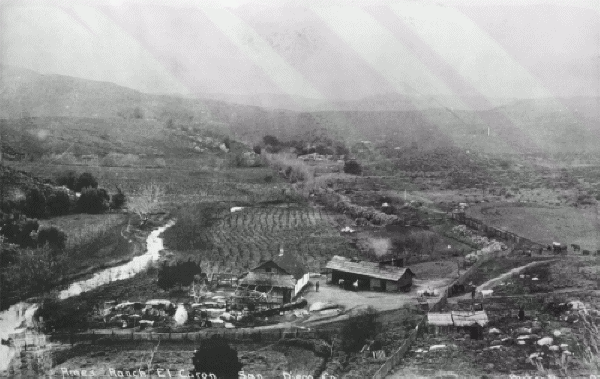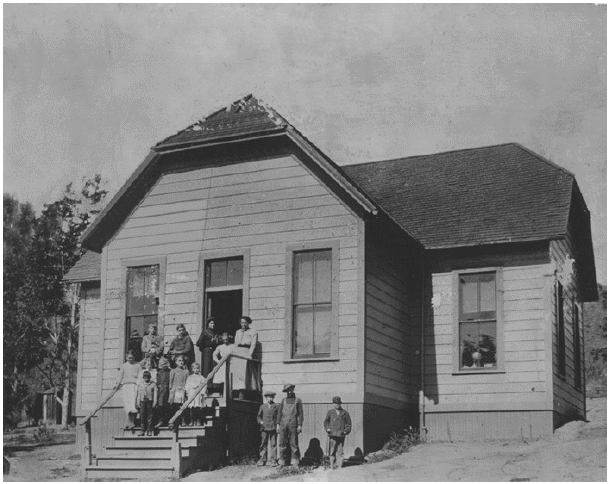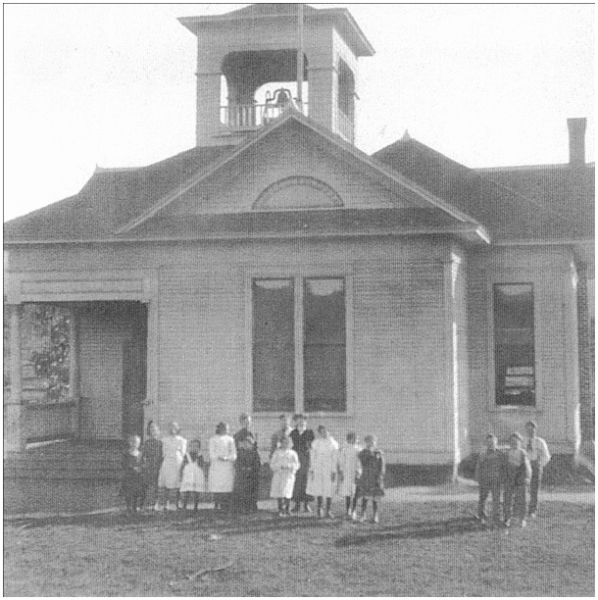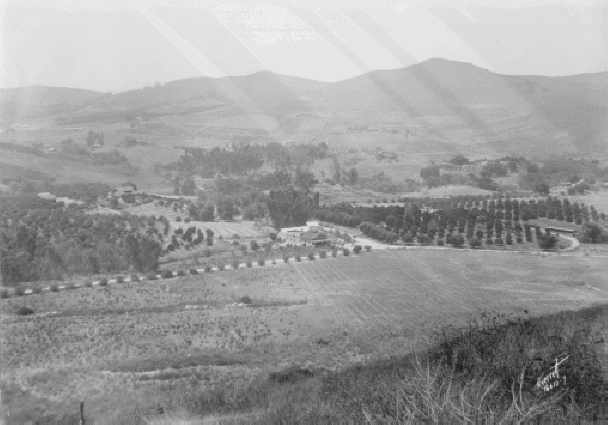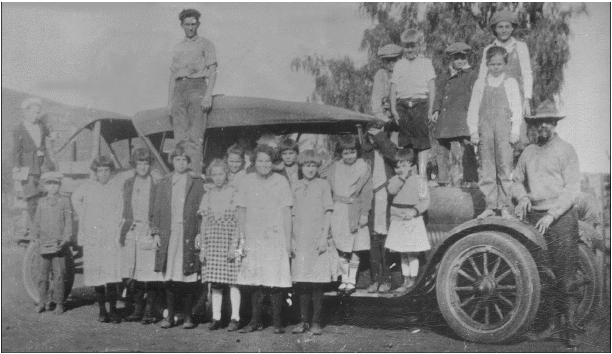Schools of Lakeside Prior to 1949
At one time Lakeside was nothing more than a large amount of land being used for grazing of animals belonging to Mission de la Alcala and cared for by the Indians of the area.
After the town of Lakeside was founded in 1886, population increased and small one-room schools were started throughout the valley. These schools came in many different forms -sheds, adobe houses, other residences and homesteaders cabins. The building was of no great importance, but education was!

Capitan Grande
One of Lakeside’s earliest schools was located in the Capitan Grande Canyon on land that is said to have been the site of an Indian village as far back as 1776. It was officially declared an Indian reservation in 1875, then in 1932 the Capitan Grande people were forced to vacate the canyon to make way for the City of San Diego’s El Capitan Dam.
Unfortunately, there is no information about the Capitan Grande Indian School. The year it was built is unknown, but possibly in the 1880’s or 1890’s. There are no class rosters available to tell us about the students or the teachers, but the children from the neighboring Conejos band may have also attended this school. There are no survivors of the original Capitan Grande band to answer questions.
Below is an 1902 photo showing a group of young people and a dignified gentleman posed in a pleasant pastoral setting. It is captioned, “Unidentified Capitan Grande school teacher and classmates, 1902.”
Allene Savage remembers a long ago day in the ’60’s when she took her father, Joe Head, up to Julian in search of a school teacher he had known as a youngster. Joe had not attended the reservation school, but he had been born on an adjacent homestead and spent much time on the Capitan Grande as a boy and a young adult. The teacher he sought had worn a beard, and the children had been fascinated with the way it bobbed up and down when he spoke. Joe found the man’s son and daughter-in-law living in a cozy home at the end of a rustic road, but the teacher had passed away. The man’s name is forgotten now, but he may well have been the gentleman in the photo.
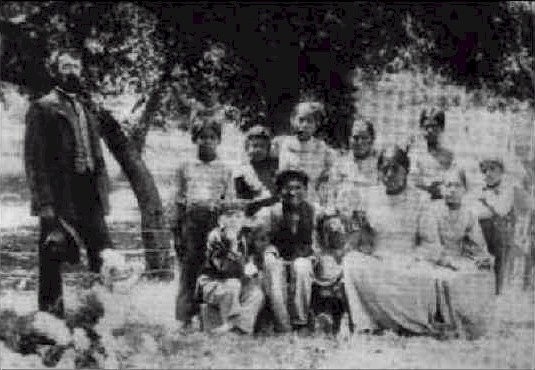
El Capitan
El Capitan School opened in 1889 with Emma Field being the first teacher. Mrs. Letha Duncan (Delores Melville’s mother-in-law), Albert Nelson and A. C. Brown were the trustees. The first semester enrollment was nine pupils.
The names of families that homesteaded in the Capitan Grande area included Henderson, Kuhner, Alford, Head, Swycaffer, Mossholder, Blattner, and Hensley, among others. Some of the families had children to send to the new school. A single track road had been built by Jonathan Perkins and Arthur Head up Chocolate Canyon to the upper elevation of Flinn Springs, and the children walked or rode horses to reach school. It was a steep incline and whether on foot or horseback, it must have been an arduous trek even in fair weather.
Possibly among its first students was Verna Carson, a granddaughter of the original Flinn family who settled Flinn Springs. She was born in the Flinn ranch house in 1882, about three weeks after Joe Head was born down on the Chocolate ranch, and both went to school at El Capitan. Verna went on to earn a teaching credential at the San Diego Normal School, then taught for many years in Fresno, eventually becoming the principal of her school. At the end of her career she came back to southern California and spent her retirement years in Alpine.
El Monte
El Monte School District held their classes in the Clarence Foster home until a school was constructed in 1915 on the south bank of the San Diego River. One acre of land was donated by the Bach Development Co. which had subdivided the El Monte Ranch in 1913.
School opened September 1915 with 15 pupils, the number needed to meet the state law. School opened with the minimum number of pupils allowed by law by the early entrance of Arthur Foster, who was not yet five years old. Some of the first students included Grace Wilkinson, Leda and Ruth Hartung (who came on their mules—Judy and Kit); Valois, Verna, Norma, Doris and Glen Melville; Art, Ruth, Dorothy, and Hazel Foster; Augusta Vanoni; and Florence Lucille, Irene and Frank Bogue. The first teacher was Laura L. Ehlers. The first trustees were Clarence Foster, John W. Fetters and Mary Fetters.
The school had been in operation less than four months when on January 13, 1916 the San Diego river changed its course and rampaged down the valley taking several homes and the new school house. It was washed away — and it was back to the Clarence Foster living room.
Item from the San Diego Newspaper, January 27, 1916:
“The El Monte School House above Lakeside has vanished like a ghost in the night! Neither on the banks where the recent floods waters have receded, nor in the river district, brought this word today to the County Superintendent of Schools. Superintendent West furnished a clue when he said he thought he had recognized the roof of the School House in the river bed near Lakeside. Fetters (Trustee) is of the opinion that the school house has disappeared by sinking into the loose, water-soaked earth. He says an attempt will be made to dig or locate it, so that it can be dug up. Meanwhile school is being held in the Clarence Foster home.
School classes were again held in the Clarence Foster living room. Dorothy Foster Lyons was a pupil in the school and she recalls the first day she started to school even though she only had to walk around the porch to the front door — she was late. Dorothy later earned her teaching credentials and taught in the Lakeside District for 24 years, mostly in Kindergarten, until she retired 1974.
A new school was built in 1917 by John W. Fetters on higher ground (five acres) donated by John Wilkinson. The El Monte school building was abandoned July 13, 1923 when the El Monte School District united with the Lakeside Grammar School District and the Lakeside Union School District was formed. The El Monte School building was sold to John Wilkinson in 1936 and the land was deeded back to him. The school house was then remodeled into a private residence.

Foster
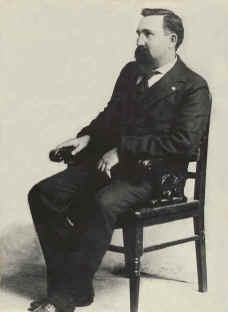
One of the earliest schools on record was “Foster School,” sometimes referred to as “San Vicente School.” Joseph Foster, County Supervisor for many years, owned the ranch which became the town of Foster.
As the population grew there was a need for a school. On the Foster ranch was a homesteader’s cabin owned by Joseph “Uncle Joe” Foster that became the first school. It was located just outside and north of the boundary line of the El Cajon Rancho Grant. The Foster School District was formed in 1879, and classes started the same year.
When the Cuyamaca-Eastern Railroad line was extended from Lakeside to Foster in 1892, the settlement aroundFoster’s Ranch grew and in 1893 was granted a post office with Angel M. Corona as Postmaster. The town of Foster was about 3 miles north of Lakeside. The Foster school lapsed July 3, 1895 when many families moved away.
January 8, 1913: 15 families living within the school boundaries, with school age children and residing at a greater distance than two miles by a traveled road from the school house, petitioned the County Superintendent of Schools for the reformation of the school district to be known as Foster School District.
The signed petition indicates some pupils lived 6 1/4 and 6 1/8 miles from the school. There were 27 children over five years of age and under 17 years of age, and six children under five years of age.
Following a hearing the petition was granted and the Foster School District was reformed February 10, 1913. The district was created from territory from Poway, El Capitan and Lakeside School Districts. The old homesteader’s school building was torn down and a new building was built in the same location.
The school lapsed again in 1925 when the last two pupils graduated. All the families had moved out after the City of San Diego purchased a large area of land for the San Vicente Dam site. During the years of 1924-1925 and 1925-1926 the pupils of the Foster District were educated at Lakeside Grammar School. Foster School district was admitted to the Lakeside Union School district February 20, 1928.
The second schoolhouse was bought by Harold Laws, a member of the Foster School Board, and moved to his lot on Orange Street (now Castle Court Drive) in Lakeside. The site of the old school is now covered by the waters of the San Vicente Dam. As of 2011, the home remains as an enlarged residence.
Lakeside Grammar School
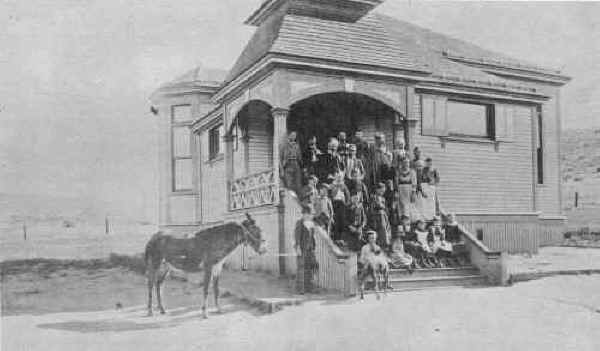
Prior to building the Lakeside Grammar School in 1890, classes were held for a time in a small shed at the corner of Sycamore (now Lakeside) and River Street. The property had been donated for use as a school by John Beadle.
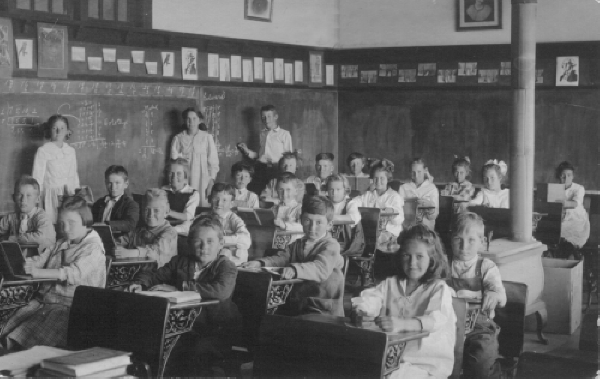
Ada Waite was the first teacher. She later became Ada Waite McClain, wife of Robert McClain. In 1890 the first grammar school was built which contained one room, and later expanded to two rooms. It was a wooden structure with a porch and cupola and housed students attending first, second and third grades. Located on Woodside and Benedict (present site of the Lakeside School central kitchen). The building burned in 1916 while graduation classes were being held at the Lakeside Town Hall. A stucco building (now the District Warehouse) had been built in 1912 and housed students in third, fourth and fifth grades in one room and sixth, seventh and eighth in another. Children from the burned building were transferred to this building. Also during this time a tent was used on this site for about one year. It had a wooden floor and wood sides three feet high. The first rain of the season caused the tent to leak and the children happily went home.
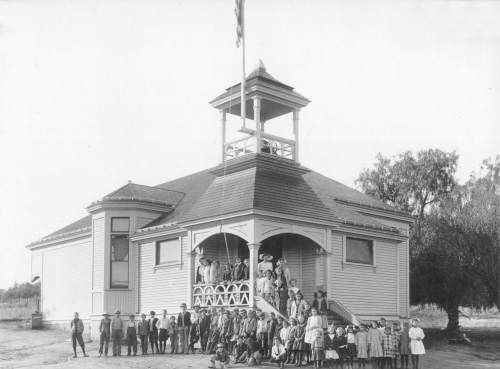
There were other small schools before the Grammar School was built. From 1890 until 1902 there was a school at Barona located just west of the present Tribal office and recreation center. Chris Duranga and Earl Fankhanel were among the students that attended school there. Another school existed at Capitan Grande Reservation, but was torn down in the early 30’s. Mrs. Blatner was a teacher there.
By 1936, population increase warranted the construction of a new building with eight classrooms, a cafeteria and office. In 1939 the first kindergarten was established with Mrs. Lenore Yakel, teacher. 1949 saw the first phase of Lindo Park construction with an addition in 1952. The next years were a period of rapid growth and called for increasing schools. In 1956 Lakeside Farms was built followed by Riverview School in 1957. Eucalyptus Hills in 1961 and Winter Gardens in 1964. In 1972 Tierra del Sol, the second Junior High School was started and for the next three years Lakeside School experienced year- round schooling.
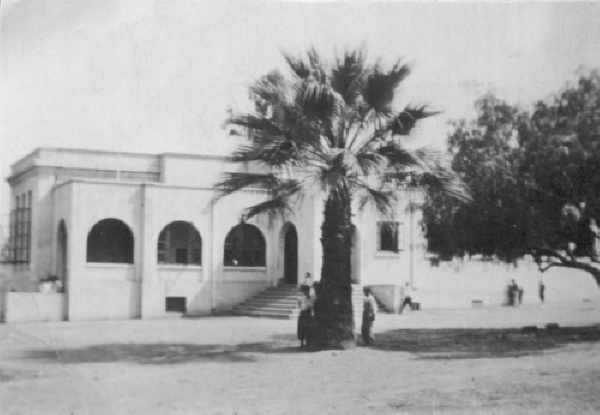
Grossmont High School
At the turn of the twentieth century, a renewed interest in the arts created an intellectual and artistic groundswell that resulted in the formation of loose-knit organizations devoted to aesthetic pursuits in various pockets of Europe and America. Artists banded together to enhance their lives and provide a mutually supportive work environment. Centers of activity sprang up in London, Paris, San Francisco, Carmel and, on a much smaller scale, in Grossmont, California, a place that appeared to have little in common with its cosmopolitan and sophisticated predecessors.
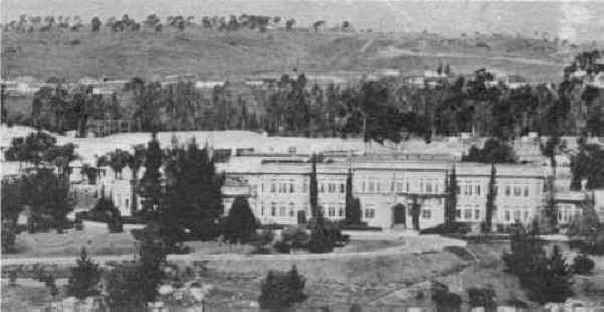
![]()
Excerpts from:
“God’s Garden:” The Grossmont Art Colony
by Kathleen Crawford
Grossmont: six hundred arid, rocky acres, bounded today by Interstate Highway 8, Fuerte Drive, Helix Drive. Pine Street and Bancroft Street, overlooks the pleasant valley of El Cajon and the gentle hills of La Mesa, twelve miles east of downtown San Diego. The small peak of Grossmont nestled beside its larger sister summit, Mount Helix, had long been used as an observation point by the citizens of San Diego. The first permanent settlement of the area took place during the mid-nineteenth century.
Granted the land in 1845, Dona Maria Antonia Estudillo, first in a long succession of owners and a member of one of the oldest families in San Diego , built a modest home at the base of the foothills. Another pioneer resident, Enoch Birdseye, followed her example and constructed his house at the foot of the knoll. The early death of Mr. Birdseye after one year ended his Grossmont residency.
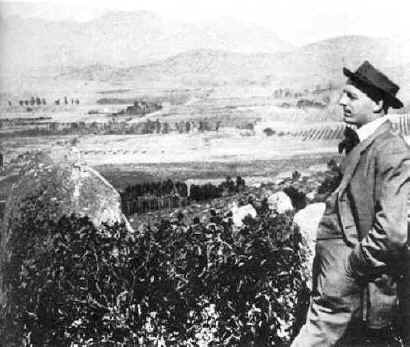
Serious development of the land commenced with the purchase of six hundred acres by Harvey C. Parke of the Parke-Davis Medical Company in Detroit, Michigan Named the Villa Caro Ranch, it soon became a show-place with its acres of lush citrus trees, fragrant with the aroma of scented blossoms. A spacious wooden Victorian home, various barns and corrals, a lily pond, and masses of deep green camellia bushes graced the property. Cork oak, mulberry, and wild persimmon trees blanketed the grounds in direct contrast to the chaparral covered slopes above.
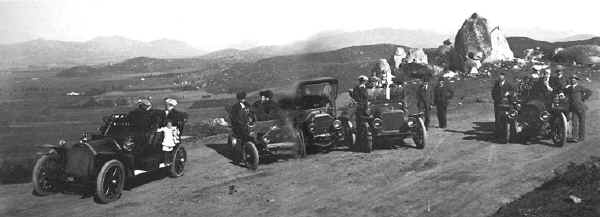
Serendipity directed the future of this small plot of land. While on a brief visit to Yellowstone National Park in 1901, Edward Fletcher, a transplanted Easterner newly settled in San Diego with his young family, struck up an acquaintance with another visitor to the park, William B. Gross. A ride in a six horse tallyho, a horse drawn buggy, cemented their friendship. They made plans to continue this bond back in San Diego and this led in time to the formation of the “Grossmont Art Colony.”
Pennsylvania-born William Gross, a theatrical agent and sometime actor, brought his talents to San Diego in response to a request from Fletcher to visit the family home. Gross, a man of medium height and stocky build, with hypnotic eyes and a red beard trimmed to a Mephistophelean point, emphasized his resemblance to King Edward VII of England. While in San Diego, the bachelor impresarios mentioned his desire for profitable investments and a peaceful retirement home to Fletcher.
Ed Fletcher, six feet tall, with a classic profile and high broad forehead capped by dark wavy hair, and patriarch of a large, handsome family, began his lucrative real estate career with the purchase of the Villa Caro Ranch in partnership with William Gross in 1902. Charmed by the rustic beauty of the ranch, the men made an offer of $11,500 in cash. The deal included forty acres of citrus trees and $85,000 worth of furniture. Included in this remarkable bargain were the Victorian home and all the outbuildings on the property. Two hundred acres of “useless” land thrown in for good measure laid the cornerstone for the artistic colony.
*Photographs from the San Diego Historical Society’s Title Insurance and Trust Collection.
Grossmont Christmas Pagent History This article is in pdf, use the button below to install Adobe Reader.
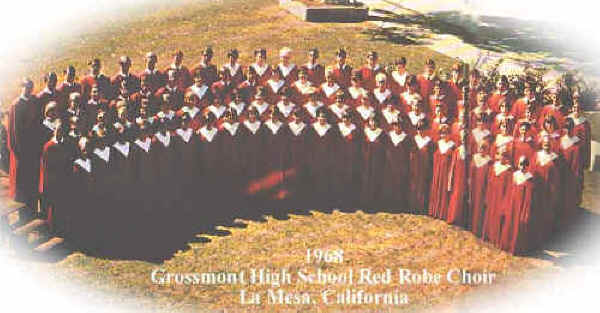
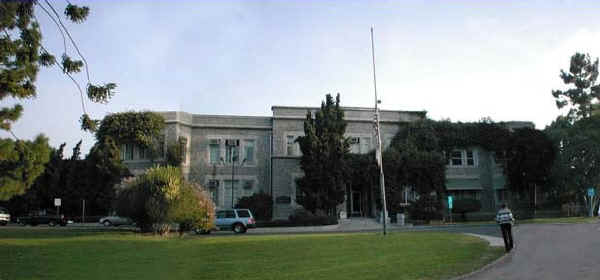
Ha-Hanna
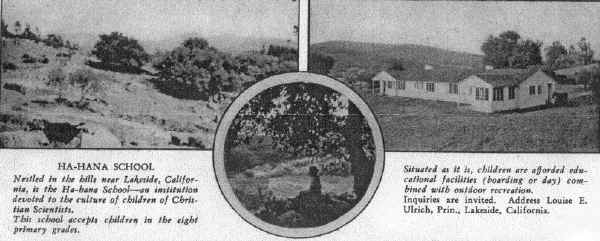
Lakeview Grammar School District
There were three ranches in our area: El Cajon, Los Coches and San Vicente. The El Cajon Rancho was given out in 1845. The area it covered was about 48,800 acres. It was made up of what is now Lakeside, El Cajon, Bostonia, Santee and Flinn Springs.
California’s smallest land grant, Rancho de la Canada de Los Coches (Glen of the Hogs), 28.37 acres, was completely surrounded by El Cajon Rancho. The Los Coches area had been in the hands of the mission Padres for many years and it was used as a grazing ground for the mission hogs. The property was sold several times and eventually sold in 1859 to Dona Perfecta and her husband Jesse Julian Ames.
Julian Jesse Ames courted Perfecta Espinosa of Old Town for 17 years and in 1838 they were married at the San Diego Mission. It was a big celebration and all the business were closed so all the residents of Old Town could attend the wedding. At the age of 56 (1859) he moved his family including eight children to the 28 acres on the Los Coches Rancho.
There with the help of his Indian friends he built an adobe home with several rooms near the Los Coches Creek. The Indians taught the family members how to select nuts and fruits that were edible and how to cook them. Julian Jessie raised cattle and sheep, grew corn and raised vegetables. He also had the first stone mill to grind corn and wheat which he grew in the El Cajon Valley.
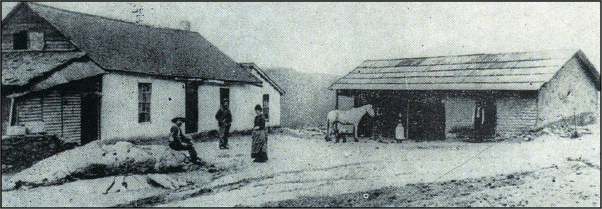

In 1866 when Perfecta was to have her tenth child, Julian went to San Diego to get the doctor, and on the return trip his wagon wheel became stuck in the mud. When Julian attempted to lift the wagon wheel he fell over dead. Perfecta continued to operate the ranch until 1888. When the Ames family was no longer using the original adobe house the home was offered to be used as the first school in the area.
The AMES ADOBE was a school for a year and a half. Verification of the adobe school was made when at a family reunion the Ames decedents recalled the stories they heard about the home being used as a school because the area did not have a school district at that time. No school records have been found. Most information about the Ames Adobe is found in “Flossie’s Notes.”
Stories were also told that Julian Jessie had hidden money in the adobe house. People came and tore down the house looking but not finding any money. The ranch was heavily mortgaged and any hidden money had been removed to keep the family on the ranch.
There were ten Ames children and many decedents. One girl named Mary was married to James Flinn in 1874. Another daughter married Jose Machado and lived in Lakeside. The youngest child was Nievas and she also lived in Lakeside. In 2011 there are Ames families living in Lakeside, north county and south bay.
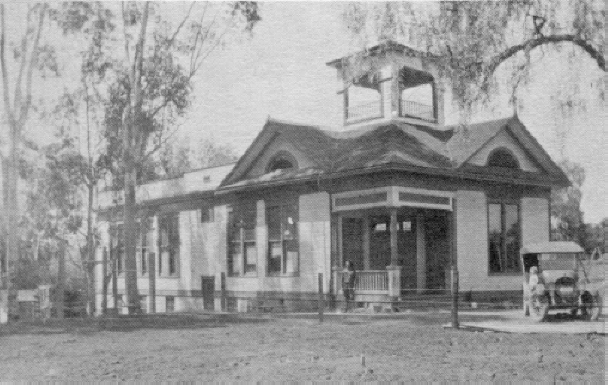
March 5, 1895 the Lakeview Grammar School District was formed by action of the San Diego Board of Supervisors. The Lakeview School was built and opened September 30, 1895. The enrollment at this time was 15 pupils, 13 in primary and 2 in upper grades, the teacher was Maude Allen, age 23. The school had one large classroom, a library room and a cloak room. The trustees were: D. F. Harbison, L. V. Hoover and D. S. Watson.
Wellington Hoover was born 1883 in Nebraska and came to Lakeside in 1895. As a young boy he attended the newly built Lakeview Grammar School. Elizabeth, his wife, came to Lakeside in 1902 and attended the Lakeview School 4th through the 8th grades. Wellington and Elizabeth married and raised fourteen children. All of the children attended Lakeview and Lakeside schools.
Wellington Hoover became the bus driver to take children from the Lakeview area to school. The amount he was paid varied as to the number trips taken and the number of pupils in each trip.
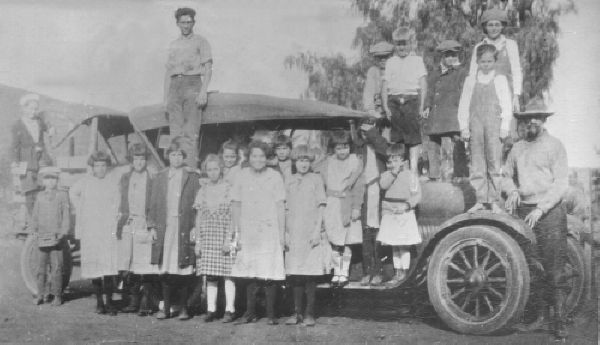
June 3, 1920 El Cajon, Hillsdale, Jamacha, El Capitan and Meridian School Districts united in forming the El Cajon Union School District. The Lakeview School closed when the district voted to join the El Cajon Union School District July 18, 1923. At this time the Lakeview School had an enrollment of 15 pupils and the district extended down to Orange Street (Castle Court Dr.) on the north boundary.
The majority of the Lakeview parents wanted to send their children to the Lakeside Grammar School even though they lived in the El Cajon Union School District. As the old laws were not rigid enough to force them to go to El Cajon most of the children came to the Lakeside Grammar School.
The new law was more rigid and obligatory that children must go to school within their districts. Both school boards must agree in order to allow the Lakeview children to attend Lakeside instead of El Cajon. So the Lakeview School District was divided. All children on the north side of Highway 80 attended Lakeside Grammar School and those on the south side of Highway 80 attended the El Cajon School. Lakeview School closed in 1920.
Riverview Union High School District
June 7, 1892, trustees of the Lakeside School District wrote the following letter to Mr. A. W. Gilbert, El Cajon.
“We the Undersigned trustees of the Lakeside School District, hereby signify our approval of the addition of the El Capitan, Dehesa, Alpine, Centre, Cowles, El Cajon, Jamacha, Spring Valley, and La Mesa School Districts to the new High School district that we have already petitioned for.”
George A. Doyle
Edward. C. Carpenter
Trustees of the Lakeside, Meridian and Cowles (Santee) School Districts met at the Lakeside Hotel in 1893 and decided the Union High School would be located at the Meridian School in the Bostonia area.
Students who attended Meridian High School rode horseback back then or drove to school in a horse and buggy. Mr. Charles Lucas says he walked and ran as he was on the track team. For a few, it was easier to ride the 6:15 A.M. train into San Diego and attend the high school but in 1915 San Diego High School ruled outsiders could no longer attend.
In 1916 Mrs. Johnson of the peach ranch on Palm Row and Mrs. Weston, mother of Mr. Claude Weston the dairyman, were successful in their efforts to establish a high school in Lakeside. Lakeside withdrew from the Meridian High School District and established its own school.

June 7, 1892, trustees of the Lakeside School District wrote the following letter to Mr. A. W. Gilbert, El Cajon.
“We the Undersigned trustees of the Lakeside School District, hereby signify our approval of the addition of the El Capitan, Dehesa, Alpine, Centre, Cowles, El Cajon, Jamacha, Spring Valley, and La Mesa School Districts to the new High School district that we have already petitioned for.”
George A. Doyle
Edward. C. Carpenter
Trustees of the Lakeside, Meridian and Cowles (Santee) School Districts met at the Lakeside Hotel in 1893 and decided the Union High School would be located at the Meridian School in the Bostonia area.
Students who attended Meridian High School rode horseback back then or drove to school in a horse and buggy. Mr. Charles Lucas says he walked and ran as he was on the track team. For a few, it was easier to ride the 6:15 A.M. train into San Diego and attend the high school but in 1915 San Diego High School ruled outsiders could no longer attend.
In 1916 Mrs. Johnson of the peach ranch on Palm Row and Mrs. Weston, mother of Mr. Claude Weston the dairyman, were successful in their efforts to establish a high school in Lakeside. Lakeside withdrew from the Meridian High School District and established its own school.
Riverview High School
Lakeside did have a high school prior to Riverview Union High School. The second floor room of the Lakeside Store in the Klauber-Wagenheim building was used for the first high school classes. This building stood on the southwest comer of Maine and Sycamore (Lakeshore). Rent for the Ross Hall was $12.50 per month. Alice Gibson, our first high school teacher, taught here and later taught at Riverview Union High School. Students entered the upper floor of the store building in Lakeside and dreamed of their longed-for new school building.
Information about Riverview Union High School has been obtained from the Board of Trustees minutes. Board members were: Judge S. G. Roberts as Board President, Charles J. Ferris as Clerk, Arthur Bertram Foster, D. H. Ehlers, and Howard L. Weston. In 1916, the August 16th meeting minutes indicate that after months of study and research by Architect Theodore C. Kistner to develop the “finest plans for the new school,” the school plans were changed to allow construction of a middle intermediate school between the main building and the manual arts building.
Prior to the school being constructed, Mr. Elmer Lawrence was hired at a salary of $50 per month to be the janitor and laborer for the buildings and grounds. In 1916, the September 23rd meeting had considerable discussion relative to equipping the school with a working library, and it was ordered by unanimous vote that $100 of the amount appropriated funds for the library, maps, charts, etc. be sent to the county librarian to secure the use of a liberal number of books. Considerable discussion was also given to purchasing one large dictionary.
At the September 30, 1916 meeting it was ordered that Prof. Adams, Principal, be asked to ascertain the ruling regarding night schools, and if possible to arrange that all except room, light and heat be furnished by the state and the county. In a 1917 circular it was stated that “Riverview was conspicuous last year in having the only night school in the state and the attendance was greater than that in the day school – a total enrollment of over 50.” The high school building was called very commodious consisting of ample classrooms, a large assembly with such added equipment as rest rooms, shower baths, projection and slide and film pictures. Business arithmetic and farm bookkeeping suited the needs of most of the students. Spanish, French, free hand and mechanical drawing, wood and iron work, classes in cooking, sewing, basketry and weaving were also offered. A one-night a week the poultry club was offered which included lectures by successful poultry men and women, as well as illustrated talks upon the essentials of the business, supplementing the far more valuable round-table discussions. The circular also stated that “Should this prove sufficiently interesting, other classes may be formed along dairy lines, including illustrative talks upon the butter fat and bacilli tests, who gets the best returns for the money invested and why. ”
“Lakeside Celebration Promises to be Greatest Ever Held in Back Country”
In 1917-1918 Riverview Union High School was built on Woodside Avenue where the Lakeside Junior High School, and now the Lakeside Middle School is located. The building alone cost nearly $25,000 and the cost of equipment was $5,000. In addition five acres of land and Lot 66 were donated by the El Monte Land Company through George J. Bach, President. The district bought another five acres for agricultural purposes, paying $1,000. Therefore, it represents an expenditure of more than $30,000. San Diego Hardware Company (which is still in existence in San Diego in 2011) was given the contract to furnish the finishing hardware for the school.
The High School Board requested the contractor to furnish the new green chalkboards in the place of slate blackboards. Bills presented included a request for $26.88 for four days of grading on school grounds, and $4.12 for a day’s labor on a school lot. Teachers were paid $1000 for one year’s work. An Underwood typewriter cost $4.00, seventy-eight desks and baskets cost $671.31, and Wallace Phillips was paid $65.00 to build a tent house for the science classes. The minutes of the Board of Trustees give an insight into allocating of funds for the building of the early school. Laws, a student, addressed the school board in the interest of the High School Baseball Club asking for ½ dozen league balls, showing that by a larger order, a better discount might be had. President Roberts consented to an order.
The spring of 1918 the new school was dedicated. Students attending the high school from La Mesa and Lemon Grove area rode the train to the Riverview Station in the community of Riverview Farms. Students did not come from El Cajon because they had their own high school. The first social affair at Riverview was a Halloween masquerade party at the Lakeside Hall, After a most enjoyable evening, which extended to the “wee small hours,” the students were declared the “best of hosts.” During the May 31, 1918, board meeting a motion was made by member Laws that the suspension of Elmer Dort by the principal be sustained by the board. The motion was not carried. Another motion was made by member Luscomb that the hearing be postponed until the June 6th meeting; Motion not carried. But at the June 7tth meeting a resolution was passed by the board that: “Whereas, Elmer Dort has filed two letters of apology with one to E. G. Adams and one to Miss Mclever; and whereas he has made a personal appeal to the board promising to do better in the future.” The board unanimously voted his reinstatement. Dean Norton of Pomona College was paid $15 for his transportation costs and foods to address the 1918 graduating class. The four year courses of study that were offered included courses in Latin, Natural Science, Engineering, Agricultural, English, and a commercial course.
Edward G. Adams was replaced by Percy R. Davis as Principal for the school year 1918-19. On March 5, 1919, Principal Davis submitted a request for a leave of absence to join the United States Army. The next year, L. W. Holland replaced Davis as principal then the following year Carl N. Vance replaced Holland.
After four years in the Riverview Farms location, Grossmont High School was built at the Grossmont Summit on land donated by Col. Ed Fletcher. Rock from two quarries owned by Col. Fletcher was donated for the building of the school with the stipulation that the district collects the rock and transports it to the Grossmont site. In the fall of 1922 classes were moved to the Grossmont site.
The Lakeside Union Grammar School District bought the Riverview Union High School building and six acres of land for $8,000. The 150 students in Second School transferred to the Riverview Union High School building, their new school, which was now named Lakeside Union Grammar School.



